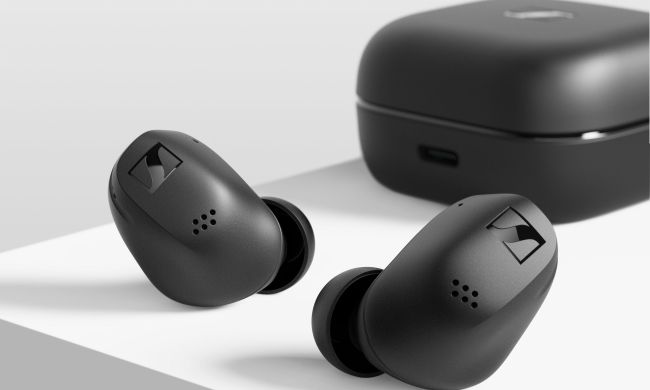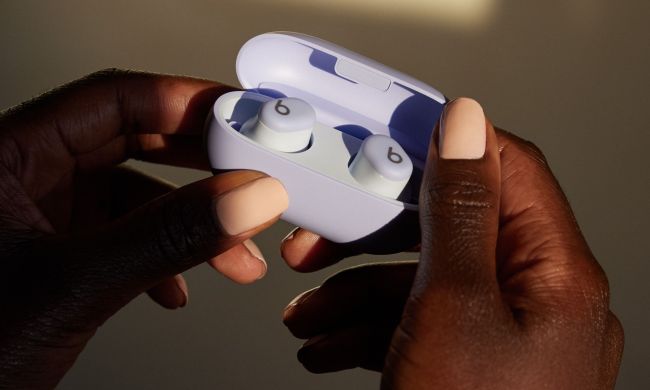As one of the biggest electronics conventions in the world, the Consumer Electronics Show in Las Vegas is packed with spectacular televisions, razor-thin laptops and outrageously fast phones. But this year, a product no one even knew how to categorize stole the show.
Melding an intuitive app with a brilliantly designed wearable, the Here Active Listening system floored us with its ability to completely tune out, amplify, and even EQ the busy show floor around us in real time. The smart earplugs (for lack of a better term) impressed even more when one of our musicians on staff took them on the road.
The only real problem was that we wished the wireless buds could stream music — and it turned out we were far from alone there. Creator Doppler Labs always envisioned Here Active as a first step in a greater goal of creating a new kind of wearable computers that can play music, alter the sonic world around you, and more. On Tuesday, the company unveiled the next step in that sonic evolution: the new fully wireless, music-playing earbuds, Here One.
A computer in every ear
“We are launching the first in-ear computer,” says Doppler Labs CEO and co-founder, Noah Kraft. Likening the Here One more to Augmented Reality devices like Microsoft’s Hololens than wireless competitors like the Bragi Dash, Kraft tells Digital Trends that his company was originally created to “transform the way people hear the world, and really to change the world of computing.”
“You should be able to go to a museum and get information on Rembrandt and still talk to your friends.”
“The way we look at it is Microsoft put a computer on every desk, Apple put a computer in every pocket, we want to be the company that put a computer … in every ear.”
Kraft says Doppler Labs’ vision stems from devices in sci-fi flicks like Her and Star Trek. He believes everyone will have a super powerful wearable (or on-body computer as he likes to call it) in their ears in the near future, and his company wants to help write that history. “Where Here Active Listening was a limited-run product,” Kraft explains, “we were always of the mindset that we’d need to offer more to really … achieve our goal of putting a computer in every ear.”
It’s all about the layers
While it’s certainly got a long way to go before it moves into the sci-fi realm, the Here One system incorporates its predecessor’s real-time control of the sound around the listener — from EQ and “adaptive filtering” to noise cancelling and amplification — and adds full wireless streaming functionality, including wireless calling and music streaming.
“When you combine all that you get these really amazing, mixed-reality layered listening experiences,” Kraft says.

As a total redesign, Kraft says Here One doesn’t just build upon the features of its predecessor, but improves upon them as well. Upgrades over the Here Active system include directional mics, designed to allow the listener to tune into conversations around them; personalized listening, which tunes the system to adapt to your own specific listening needs; and calibration that can recognize and diagnose your own hearing issues, which can then be applied across the system.
With the inclusion of wireless streaming, Kraft sees all sorts of applications that could theoretically allow the Here One to be an augmentation device that changes your daily listening environment. Here One’s so-called layered listening could allow you to control what you hear in the outside world as well as what you pipe into the buds, down to the percentage point.
“You should be able to go to a museum and get information on Rembrandt and still talk to your friends, go to a movie and hear director’s commentary, or go to a ball park and hear stats, but still be able to hear the outside world.”
Making wireless work
While other earbuds have similar technology, such as the Bragi Dash’s “Transparency Mode,” after listening to the Here Active, we’re excited about Doppler Labs’ tailored version. And after some lackluster experiences, we’re also interested to see if Here One can overcome some of the challenges of its peers to become a more dependable wireless listening solution.

The biggest problem with most wireless buds thus far has been a lack of stable connection between the stereo buds, both to each other, and to their sound source. When we asked Kraft about these well-documented issues of other wireless buds, he had a rather intriguing answer.
“Frankly, the tech has evolved,” Kraft told Digital Trends. “There are gonna be a hundred wireless earphones within the next 12 months. [The wireless connection] is a problem that’s been fixed and will continue to be fixed, especially as Apple and Bose and a few others enter the mix.”
A smarter wireless solution
Even with cutthroat competition from the big boys likely to enter the wireless market soon, however, Kraft sees Here One as being “the only smart hearing device.”
“We really want to be a computing platform. The streaming functionality is just one small part of that.”

The user interface is also a huge focus for the Doppler team as they prepare to roll the Here One out in November. While the Here Active app is quite intuitive, the company is actually still working on ways to make Here One easier to use, even with your phone in your pocket.
“We want you to take out the phone as little as possible,” Kraft said. “Let’s just say we have several tricks up our sleeve …”
Of course, apart from all those fancy features, we’ll also have to wait and see just how good the Here One actually sound. Kraft tells us that 50 of Doppler Labs’ 70 employees are engineers, snatched up from companies like Microsoft, Google, Nest, and Apple. He didn’t mention any engineers from, say, Sennheiser, AKG, Beyerdynamic, or other industry leaders in the headphone game, though a PR representative later reached out to us, saying that Doppler did in fact hire acousticians from Sennheiser and Dolby.
At $299, the Here One will immediately be competitive with other wireless earbuds in their class. Toting an impressive first outing from Doppler on their resume, adaptive listening that can be calibrated for each user’s individual hearing needs, and powerful tools to alter the sound around you, these buds are already packed with promise.
You can pre-order the new Here One active earbuds at Doppler Labs’ website now, with delivery slated for November.
Updated 6-28-2016: Added information per Doppler Labs PR about the company’s acousticians.


